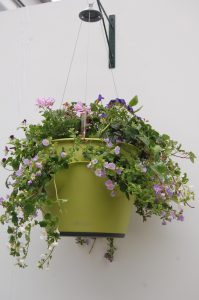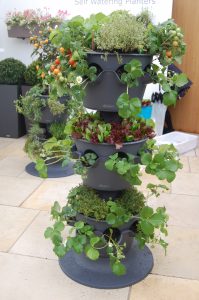Weeks have passed without a drop of rain and the drought is really starting to take its toll on our gardens. Prioritising your watering is the name of the game right now – then think of how to save water in the future.
Becoming a water-wise gardener is sensible at any time, but particularly when the prospect of hosepipe bans is looming large. Thoughtful water use and targeting which plants need it most is a very good idea all round which ticks quite a few boxes. Financially, you’ll save money if on a water meter; looking at the bigger environmental picture, it reduces use of a valuable resource; and time-wise, you won’t spend hours attached to the business end of a hose pipe.
Some areas of your garden can be ignored
Lawns can be left to go brown (they’ll green up incredibly fast once we get some rain) and established plants like trees, shrubs, perennials or roses should have such good root systems that they’ll cope for weeks without water.
But do prioritise these plants:
Top of the list are all plants in containers. I tend to think of them rather like pets – they depend on you for everything, especially water. In this heat expect to water daily, especially hanging baskets which dry out incredibly fast on breezy days. Improve drought tolerance by planting in large pots (small ones dry out incredibly fast) and group containers close together so they shade each other. Another option is self-watering containers like these ones pictured below, by Lechuza. The name is slightly misleading as they still need watering – just less frequently, as there’s a built-in water reservoir in the base.
Veg should be well up the priority list and certain ‘thirsty’ types need a steady supply of water, particularly fleshy-fruited cucumbers, courgettes, marrows, pumpkins, and leafy salads. Tomatoes ‘split’ or suffer from blossom end rot if watered erratically; beans get horribly stringy if they go short; while others simply end up with a pathetically small crop. A good watering every couple of days should keep all of these going. Then next in the pecking order is anything newly planted since spring (which won’t have established enough of a root system yet to survive the drought for long). Small plants like bedding need doing every day or two, while larger long-lived ones (perennials, shrubs and the like) should have a really thorough soaking once every week or so. A light watering can do more harm than good, as it encourages roots to quest upwards in search of moisture which then makes them more vulnerable to drought and heat.
Time your watering:
When you water is important too. Ideally this should be early in the morning or in the evening when less water is lost by evaporation, and also avoids the hazard of watering in hot sun – droplets splashed onto the leaves can act like little magnifying glasses and cause unsightly scorched patches. But if something is obviously in distress – wilting, drooping or shrivelling – water immediately, whatever the time of day. Regardless of when you’re watering, always direct the flow onto the soil rather than onto the leaves which can cause disease spores to spread.
Save water, save money:
Avoid using mains water if possible, and instead use water butts to collect rainwater – better for plants, your water bill and the environment. Any building that has gutters and a downpipe (or can be fitted with one) – even a shed or greenhouse – gathers an impressive amount of water. You can link several butts together, and fit rain diverter devices to downpipes that shut off when the butts are full. For easy access, put a butt on a stand or stack of bricks. Open water tanks are good for dipping a watering can, and if they become breeding grounds for mosquitos, introduce a couple of goldfish to munch them up. There’s no need to get worn out carrying heavy cans, as tailor-made pumps can easily deliver water around the garden; there are even solar powered ones for the ultimate in eco-friendliness.
Reuse household waste water:
When supplies run low, make the most of household ‘grey’ or waste water. Water from the kitchen or hand-washing can be safely used on any plants, unless it contains strong chemicals like bleach, disinfectant and dishwasher salts. Bath or shower water is fine on ornamentals but avoid using on edible plants due to the slight risk of contamination with bacteria. Even small actions help: if you use loose tea or coffee, rinse out pots and empty the whole lot onto your plants – coffee grounds help deter slugs, too.
Future-proof your garden
As climate change takes hold, drought interspersed with heavy rain is something we’re likely to see more, which has led to an upsurge of interest in ‘rain gardens’. Planned to gather and reuse every drop that falls, this design of garden incorporates features such as green roofs to minimise runoff, rainwater storage and reuse systems, permeable paving, and contoured layouts including low-lying ‘swales’ or water-holding planted areas that are intended to be seasonally dry, along with permanent pools. Planning for extremes means you have a much better chance of being able to sit back and enjoy your summer garden, rather than being a slave to the watering can. You can’t beat getting nature on your side.

